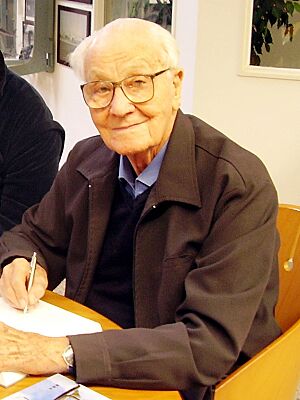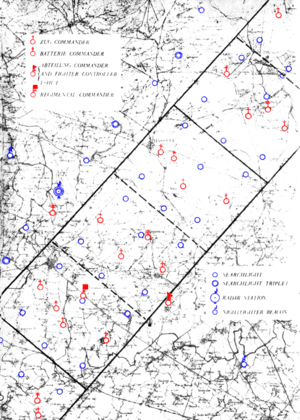Martin Drewes facts for kids
Quick facts for kids
Martin Drewes
|
|
|---|---|

Martin Drewes at the Aviation Museum Hannover-Laatzen in 2011
|
|
| Born | 20 October 1918 Lobmachtersen, Province of Hanover, Kingdom of Prussia, German Empire (now Salzgitter, Lower Saxony, Germany |
| Died | 13 October 2013 (aged 94) Blumenau, Santa Catarina, Brazil |
| Allegiance | |
| Service/ |
Army (1937–39) Luftwaffe (1939–45) |
| Years of service | 1937–45 |
| Rank | Major (Major) |
| Unit | ZG 76, NJG 3 |
| Commands held | III./NJG 1 |
| Battles/wars | |
| Awards | Knight's Cross of the Iron Cross with Oak Leaves |
| Other work | Civil pilot, businessman |
Martin Drewes (born October 20, 1918 – died October 13, 2013) was a German pilot in the Luftwaffe (the German air force) during World War II. He was known as a "night fighter ace," meaning he was a very skilled pilot who shot down many enemy planes, especially at night. He achieved 52 victories, with 43 of them happening during night flights in his Messerschmitt Bf 110 heavy fighter plane. Most of his victories were against Royal Air Force (RAF) bombers over the Western Front, protecting Germany.
Born in Lobmachtersen, Germany, Drewes grew up during a time of big changes in his country. After finishing school, he joined the German Army in 1937 and then moved to the Luftwaffe in 1939 to become a pilot. He flew his first combat missions in early 1941. In May 1941, he took part in the Anglo-Iraqi War and claimed his first aerial victory (shooting down an enemy plane) on May 20, 1941. In November 1941, Drewes joined the night fighter force. He got his first night victory on January 17, 1943. By February 1943, he became a squadron leader (Staffelkapitän), and in August 1943, he transferred to another night fighter wing.
Contents
Early Life and Training
Martin Drewes was born on October 20, 1918, in Lobmachtersen, which is now part of Salzgitter, Germany. His father was a pharmacist. Martin had two sisters, Hanna and Käthe. After high school, he joined the German Army on November 2, 1937, as a Fahnenjunker (an officer cadet, or someone training to be an officer). He trained with a tank regiment and later went to a military school in Munich. There, he became friends with Chiang Wei-kuo, who was the adopted son of the Chinese President, Chiang Kai-shek.
On August 1, 1939, Drewes became a second lieutenant (Leutnant) and then joined the Luftwaffe on September 1. He trained to be a pilot, learning how to fly different types of aircraft, including aerobatics, navigation, and flying in difficult conditions. He also learned to fly by instruments and at night. In October 1940, he began training as a "destroyer" pilot, flying twin-engine fighter planes.
In March 1943, Martin Drewes married Wulfhild Ellen Erna Wegener. They had a daughter, Wulfhild, born in January 1944. Drewes even painted his wife's initials, "WD," on the tail of one of his planes. They later divorced in 1948.
World War II Combat
World War II in Europe started on September 1, 1939, when Germany invaded Poland. On February 8, 1941, Drewes joined a squadron of Zerstörergeschwader 76 (ZG 76), which was a "Destroyer Wing." His squadron flew Messerschmitt Bf 110 twin-engine heavy fighters, patrolling over the North Sea.
This group, known as the "Shark Group" because of their plane's special paint, was sent to Greece during the Balkans campaign. In May 1941, Drewes' squadron was ordered to Iraq to support Iraqi rebels who wanted independence from the British. Drewes flew 36 combat missions there, including 17 "ground attack" missions, where he attacked targets on the ground. On May 20, he shot down his first enemy plane, a Gloster Gladiator biplane from the RAF. By May 26, his unit had to retreat because they ran out of working planes. That day, he received the Iron Cross 2nd Class, a military award.
In mid-1941, Drewes' squadron returned to patrolling from airfields in the Netherlands. On August 29, he claimed his second aerial victory, shooting down a Supermarine Spitfire over the sea. On November 1, he was promoted to first lieutenant (Oberleutnant). His unit then became a night fighter group, called III. Gruppe of Nachtjagdgeschwader 3 (NJG 3).
Becoming a Night Fighter Ace
After 1939, the RAF started attacking Germany mostly at night. To defend against these attacks, Germany set up a night air defense system called the Kammhuber Line. This system used radars and searchlights to find enemy bombers and guide German night fighters to them. Later, German night fighters also started using their own airborne radars, like the Lichtenstein radar, to find planes in the dark.
In January 1942, Drewes' unit moved to northern Germany to protect Hamburg from air raids. In February, he flew missions to support "Operation Donnerkeil," which helped two German battleships, Scharnhorst and Gneisenau, and the cruiser Prinz Eugen escape from France to German ports. From May to June 1943, he flew special missions in Norway, including escorting the battleship Tirpitz. Drewes achieved his first night victory on January 17, 1943, when he shot down a Short Stirling bomber.
Leading Squadrons and Groups
In February 1943, Drewes became the squadron leader (Staffelkapitän) of 7. Staffel of NJG 3. His squadron was based in Copenhagen, Denmark. He claimed his second night victory on March 14, 1943, shooting down a Handley Page Halifax bomber. On April 9, he received the Iron Cross 1st Class.
In August 1943, Drewes was made the permanent squadron leader of 11. Staffel of Nachtjagdgeschwader 1 (NJG 1). On October 3, 1943, his Bf 110 plane was hit by enemy fire and badly damaged, forcing him to make an emergency landing. Drewes also shot down two Boeing B-17 Flying Fortress bombers during daytime missions on January 11, 1944. For his achievements, he received the German Cross in Gold on February 24, 1944.
On March 7, 1944, Drewes was put in charge of III. Gruppe (3rd group) of NJG 1, becoming its acting group commander (Gruppenkommandeur). On March 30-31, 1944, Drewes shot down three Avro Lancaster bombers during a raid on Nuremberg. One of these was a Lancaster from No. 9 Squadron RAF.
His assistant at the time was Walter Scheel, who later became the President of West Germany. On the night of July 21-22, 1944, Drewes shot down two more Lancaster bombers, but his own plane was also hit. Although he was injured, he and his crew managed to parachute to safety.
By the end of the war, Martin Drewes had flown 252 missions. He claimed a total of 52 victories, including a Spitfire, a Gladiator, seven American 4-engine bombers shot down during the day, and 43 British bombers at night. Most of these victories were achieved with his loyal crew, Georg "Schorsch" Petz and Erich Handke. Drewes received the Knight's Cross and the Oak Leaves, two very high military honors. He was captured by British forces when the war ended.
Later Life
Martin Drewes was released from captivity in February 1947. He then left Germany and traveled to Italy. From there, he took a ship to Brazil, arriving in Rio de Janeiro on August 20, 1949. For a couple of years, he worked as a pilot and in aerial photography.
In Brazil, he became a successful businessman. He married a Brazilian woman named Dulce Hurpia, and they had a son, Klaus Drewes, who became a lawyer. Their long marriage lasted until Dulce's death in 2010. Martin Drewes visited Germany at least once a year. He passed away on October 13, 2013, in Blumenau, Brazil, at the age of 94.
Summary of Career
Martin Drewes was a highly decorated pilot during World War II. He was known for his skill as a night fighter, protecting Germany from enemy bombers.
Awards
- Iron Cross (1939)
- 2nd Class (May 26, 1941)
- 1st Class (April 9, 1943)
- Front Flying Clasp of the Luftwaffe for Night Fighters
- in Silver (July 2, 1941)
- in Gold with Pennant "200" (January 18, 1945)
- German Cross in Gold on February 24, 1944, as a first lieutenant in NJG 1
- Honour Goblet of the Luftwaffe (Ehrenpokal der Luftwaffe) on May 1, 1944, as a first lieutenant and pilot
- Knight's Cross of the Iron Cross with Oak Leaves
- Knight's Cross on July 27, 1944, as a captain and group commander of III./NJG 1
- 839th Oak Leaves on April 17, 1945, as a major and group commander of III./NJG 1
Dates of Rank
- August 1, 1939: Leutnant (Second Lieutenant)
- November 1, 1941: Oberleutnant (First Lieutenant)
- April 20, 1944: Hauptmann (Captain)
- December 1, 1944: Major (Major)


